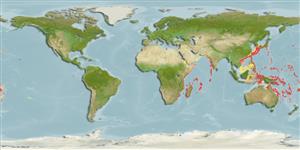>
Beryciformes (Sawbellies) >
Berycidae (Alfonsinos)
Etymology: Beryx: Greek, beryx or berys = a name of a fish. Cuvier & Valenciennes (1829:221) precise that the name was used by Gesner from Varinus, but with no indication whatsoever helping identifying any species. After D'Arcy Wentworth Thompson (A glossary of Greek fishes, 1947), the name actually seems to come originally from Hesychius, but perhaps the name was not originally a fish name. Thompson compares it to meryx (ruminant), applied on skaros (Scarus), so it may have been applied on a parrot fish referring to its browsing/grazing behavior described by Aristoteles and followers.
Environment: milieu / climate zone / depth range / distribution range
Écologie
marin benthopélagique; profondeur 100 - 500 m (Ref. 42565). Deep-water
Northwest Pacific: Japan. Also known from the Western Indian Ocean.
Taille / Poids / Âge
Maturity: Lm ? range ? - ? cm
Max length : 30.0 cm SL mâle / non sexé; (Ref. 42565)
Description synthétique
Clés d'identification | Morphologie | Morphométrie
Épines dorsales (Total) : 4; Rayons mous dorsaux (Total) : 12 - 13; Épines anales: 4; Rayons mous anaux: 27 - 32.
Life cycle and mating behavior
Maturité | Reproduction | Frai | Œufs | Fécondité | Larves
Hayashi, M., 2002. Berycidae. p. 485-486. In T. Nakabo (ed.). Fishes of Japan with pictorial keys to the species (second edition). Tokai University Press, 1749 p. (Ref. 42565)
Statut dans la liste rouge de l'IUCN (Ref. 130435: Version 2024-1)
Menace pour l'homme
Harmless
Utilisations par l'homme
Outils
Articles particuliers
Télécharger en XML
Sources Internet
Estimates based on models
Preferred temperature (Ref.
123201): 12.6 - 21.3, mean 16.2 °C (based on 189 cells).
Phylogenetic diversity index (Ref.
82804): PD
50 = 0.6260 [Uniqueness, from 0.5 = low to 2.0 = high].
Bayesian length-weight: a=0.01122 (0.00514 - 0.02450), b=3.04 (2.87 - 3.21), in cm total length, based on all LWR estimates for this body shape (Ref.
93245).
Niveau trophique (Ref.
69278): 3.9 ±0.5 se; based on size and trophs of closest relatives
Résilience (Ref.
120179): Faible, temps minimum de doublement de population : 4,5 à 14 années (Preliminary K or Fecundity.).
Fishing Vulnerability (Ref.
59153): Low to moderate vulnerability (27 of 100).
